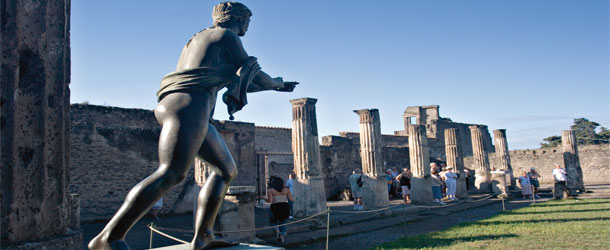Anyone who’s a Monty Python fan will surely know the answer to the question posed in this blog’s title, and indeed, they’ve left us with a lasting legacy or architectural wonders to marvel at. Even better, there’s plenty of them that you can see while on your cruise, so here’s six of the best.
Diocletian’s Palace, Split, Croatia
Nestled in a bay on the Dalmatian Coast, this spectacular structure was built by the Emperor Diocletian and at the time was surely one of the world’s fanciest retirement homes, as it was here that he lived out his days after becoming the first Roman Emperor to abdicate. The palace is one of the city’s most popular tourist attractions and a must-see if you visit.
How to see it: Book a cruise which explores the Adriatic and includes Split on its itinerary.
Pompeii, Naples, Italy
You’re probably familiar with the story of Pompeii, when in 79AD, Mount Vesuvius erupted and completely engulfed the town. The resulting mountain of ash and soil preserved Pompeii, trapping it forever in time and today, you’ll see everything from buildings and paintings to the town’s very inhabitants. Fascinating and moving, it offers an enthralling look at ancient Roman life.
How to see it: Book a Mediterranean cruise which calls at Naples and book a shore excursion to Pompeii.
Amphitheatre of El Djem, Tunisia
The world’s third largest Roman amphitheatre was built in the early third century by Emperor Gordian I and can hold around 35,000 spectators. It remained relatively intact up until the 17th century when stones from it were used to build El Djem and appropriately considering this blog’s title, it was used in the filming of some scenes from Monty Python’s Life of Brian as well as Ridley Scott’s sword and sandals epic Gladiator.
How to see it: Book a Middle Eastern cruise which calls at the port of Sousse in Tunisia and book an excursion to El Djem.
Pont du Gard, Gard, France
What would this blog be without an aquaduct? This one’s located in the south of France and was built to supply the inhabitants of Roman city Nimes with Fresh water. Spanning the Gardon River, the Pont du Gard is its centrepiece; a spectacular feat of architecture built without the use of mortar and the highest and best-preserved Roman aquaduct in the world and one of France’s most popular tourist attractions.
How to see it: Book a Mediterranean cruise which calls at the port of Marseilles and join a shore excursion to Pont du Gard.
Pantheon, Rome, Italy
Now we get to the first of Rome’s big-hitters, the Pantheon. One of the best-preserved Roman buildings in the world, it was built in 126AD to honour all the Roman gods and boasts the largest unreinforced concrete dome in the world. Since the 7th century, it has been in use as a Roman Catholic Church, the Santa Maria della Rotonda.
How to see it: Book any cruise which includes Rome on its itinerary.
The Colosseum, Rome Italy
Probably Rome’s most recognisable landmark, it’s the largest amphitheatre in the world and dates back to 80AD, when Emperor Titan completed the work his father Vespasian began. Reluctant combatants who took part in the Colosseum’s many elaborate spectacles and opening ceremonies would be watched by a staggering 50,000 spectators, who would have the choice of 80 entrances. It’s one of Roman Empire’s crowning architectural achievements and must-see when visiting Rome.
How to see it: Book a cruise which includes Italy’s capital on its itinerary.


Comments: no replies